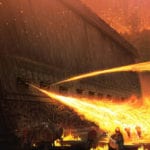 Technology
Technology  Technology
Technology  Mysteries
Mysteries 10 Mysteries of the Human Genome
 Weird Stuff
Weird Stuff 10 Things So Rare They’ve Only Been Found Once
 History
History 10 Legends Whose Last Moments Undid Their Glory
 Health
Health 10 Futuristic Ideas to Treat Common Medical Problems
 Weird Stuff
Weird Stuff Ten Surreal Attempts to Reverse Baldness
 Facts
Facts 10 U.S. Government Contingency Plans for the Unthinkable
 History
History 10 Weird Distractions from the Great Depression
 Movies and TV
Movies and TV 10 Fictional Kings Who Go from Good to Bad
 Food
Food The Fantastic Chemistry Behind Why 10 Popular Foods Taste So Good
 Technology
Technology 10 Modern Technologies That Accidentally Imitate Ancient Magic
 Mysteries
Mysteries 10 Mysteries of the Human Genome
 Weird Stuff
Weird Stuff 10 Things So Rare They’ve Only Been Found Once
Who's Behind Listverse?

Jamie Frater
Head Editor
Jamie founded Listverse due to an insatiable desire to share fascinating, obscure, and bizarre facts. He has been a guest speaker on numerous national radio and television stations and is a five time published author.
More About Us History
History 10 Legends Whose Last Moments Undid Their Glory
 Health
Health 10 Futuristic Ideas to Treat Common Medical Problems
 Weird Stuff
Weird Stuff Ten Surreal Attempts to Reverse Baldness
 Facts
Facts 10 U.S. Government Contingency Plans for the Unthinkable
 History
History 10 Weird Distractions from the Great Depression
 Movies and TV
Movies and TV 10 Fictional Kings Who Go from Good to Bad
 Food
Food The Fantastic Chemistry Behind Why 10 Popular Foods Taste So Good
Top 10 Amazing Chemical Reactions
Chemical reactions are part of our daily lives. From cooking in the kitchen, to driving a car, these reactions are commonplace. This list is aimed at some of the more exotic and amazing reactions that most of us have not seen or experienced. My knowledge of science is limited, so if I have made a blunder in my descriptions, please let me know so that I can correct them! Here are the top 10 amazing chemical reactions. Do not try these at home (but if you do – send us the video clips!)
Sodium is a highly combustible element and the addition of water can make it explode. In this video we see a drop of water added to a small piece of sodium in a flask filled with chlorine gas. The distinctive yellow color of the light emitted is due to sodium’s ‘D lines’ – this is often used in street lighting. This experiment produces a great deal of heat. When you combine sodium and chlorine, you get sodium chloride – common salt.
Magnesium ignites easily and burns very brightly. In this experiment, you see magnesium ignited in a shell of dry ice – frozen carbon dioxide. Magnesium is able to burn in carbon dioxide and nitrogen. Because of its brilliant light, it was used in early photographic flashes, and it is still used in marine flares and fireworks.
Potassium Chlorate is a compound containing potassium, chlorine and oxygen. It is often used as a disinfectant and in fireworks and explosives. When potassium chlorate is heated to melting point, any item added to it will cause a rapid disintegration in the form of an explosion (as we see in the video above). The gas coming off the potassium chlorate is oxygen. Because of this, it is often used in airplanes, space stations, and submarines as a source for oxygen. A fire on the space station Mir was attributed to this substance.
When a superconductor is cooled to below its transitional temperature, it becomes diamagnetic: this is when something is repulsed from a magnetic field rather than drawn in to it. This discovery by Meissner has lead to the concept of frictionless transportation, as an object could be “floated” along a track rather than “attached” to it by wheels.
Sodium acetate, when heated and cooled, becomes supersaturated in water. When it comes in contact with another object it re-crystalizes. This reaction also causes heat, and so this has a practical use in heat pads. Sodium acetate is also used as a preservative, and also gives salt and vinegar chips their distinctive taste. It is referred to in foods as E262 or sodium diacetate.
Superabsorbent polymers (also known as hydrogels) are able to absorb extremely large amounts of liquid relative to its own mass. For this reason, they are used in the commercial production of diapers, and incontinence garments, and other fields requiring protection from water or liquids such as underground cabling.
Sulfur Hexafluoride is a colorless, odorless, non-toxic and non-flammable gas. Because it is over 5 times denser than air, it is able to be poured in to open containers and light weight objects can float on it as if it were water. Another fun use for this harmless gas is through inhalation; when inhaled, it lowers the voice drastically – the exact opposite of helium. You can see that effect here:
The reason that your voice is lowered when you inhale sulfur hexafluoride is that the weight of the gas slows the sound waves produced in your vocal tract to just under half the speed of the sound. Helium works in the opposite way.
When helium is cooled cooled to -271c, it reaches the lambda point. At this stage (as a liquid) it is known as Helium II. Hellium II is a superfluid. When it flows through even capillaries of 10?7 to 10?8-m widths it has no measurable viscosity. In addition, it will creep up a container (as it seeks out a warmer area) seemingly against the effects of gravity. Just watch the clip above and be amazed!
Thermite is aluminum powder and a metal oxide which produces an aluminothermic reaction known as a thermite reaction. It is not explosive, but it can create short bursts of extremely high temperature. A thermite reaction is initiated with some type of detonator and it can burn at temperatures of thousands of degrees. In the clip above we see an attempt to “cool” the thermite reaction by dumping it in a vat of liquid nitrogen.
The Briggs-Rauscher reaction is known as an oscillating chemical reaction. According to Wikipedia: “the freshly prepared colorless solution slowly turns an amber color, suddenly changing to a very dark blue. This slowly fades to colorless and the process repeats, about ten times in the most popular formulation, before ending as a dark blue liquid smelling strongly of iodine.” The reason this occurs is that the first reaction causes certain chemicals to be released in to the liquid, which then, in turn, spark a second reaction, and the process repeats itself until exhausted.








